Clematis Madame Julia Correvon - how to care for a plant
Clematis is one of the most beautiful plants of a temperate climate, a favorite of Russian gardeners. Reliable and resistant varieties that can quickly cover the surface of an arch or a gazebo, while blooming abundantly and for a long time, are of significant value. These include Madame Julia Correvon (Mme Julia Correvon). Its flowers attract with their graceful form and rich wine-red hue.
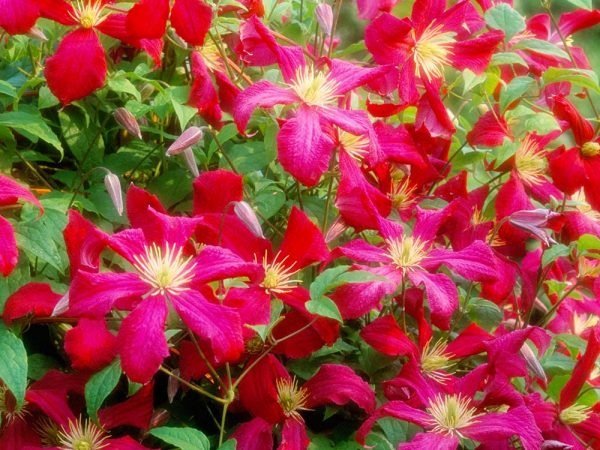
Clematis madame julia correvon
Variety characteristics
Clematis Madame Julia Correvon was brought out in 1900 by the French originator F. Morel. The variety comes from seedlings of purple clematis (klematis Viticella), belongs to the third pruning group.
Clematis Viticella is characterized by strong growth and abundant flowering on the shoots of the current year. Bloom in late June - July, flowering lasts about a month. Sometimes they give single flowers in the fall.
External description
The flowers are medium-sized (5-13 cm), wine-red with an intensely bright stripe in the center. The petals are wavy, with deep veins, curling, rhombic in the amount of 4 to 6. Anthers are golden yellow on white threads, contrasting with the tone of the flower.
Flowering occurs in July - August. Vigorous variety, height 2.5-3.5 m. Has a premium award from the Royal Horticultural Society of Great Britain.
Landing features
Clematis Madame Julia Correvon is a rather powerful liana, she will need a support about 3 m high. Lattices, arches, trellises are suitable as supports.
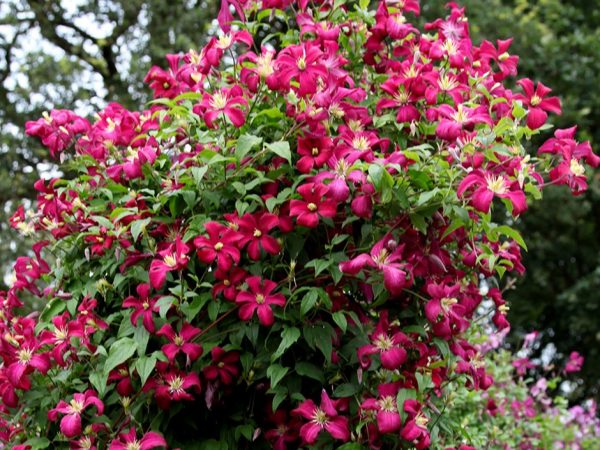
Clematis Madame Julia Correvon Description
The planting hole is made no closer than 50 cm from the wall of the house so that the roots are not damaged by storm drains and ice floes from the roofs.
Timing
Clematis is planted in open ground in both spring and autumn. Spring planting is preferred. In addition, the choice of planting material is more varied in the spring.
Planting dates depend on the growing region and soil readiness. In the southern regions of Russia, clematis are planted in early April, in the northern regions, in Siberia - in the first half of May. You need to plant clematis until the young shoots germinate from the buds. This applies to plants with open roots. Container-rooted seedlings can be planted until the first half of June.
In early autumn, in September - early October, you can also transplant clematis, plant adult bushes during reproduction by division.
Site preparation
The planting site is chosen carefully, because the culture lives in a permanent place for up to 30 years. The optimal landing site meets the conditions:
- good sunlight;
- shelter from the wind;
- the distance of the landing pit from the walls of the buildings is not less than 0.5 m;
- protection from the sun, partial shade is desirable at midday;
- loose, fertile soil of slightly alkaline reaction.
Before planting, the soil is dug up, freed from weeds and filled with humus, compost, superphosphate.Sour must be deacidified with slaked lime.
Preparation of planting material
Saplings are found in two variations: in the form of rooted cuttings (in bags) and in pots with a closed root system.
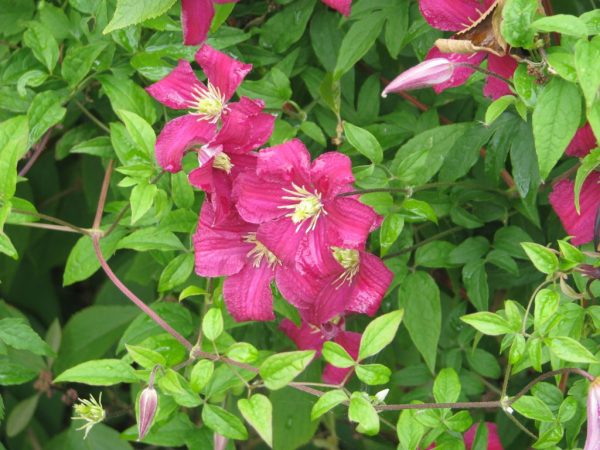
Clematis madame julia correvon
If possible, choose 2-3 year old plants in containers, they have already developed a root system and will take root faster. Cuttings with roots will lag behind them in development for at least a year.
Seedlings in pots are hardened in partial shade for several days, gradually accustoming them to sunlight. If they have leaves, the first time they are shaded after planting. The buds are carefully cut.
The advantage of seedlings in packages is their low cost. Signs of a healthy planting material:
- strong, branched root lobe;
- stems without spots, rot and damage;
- at least 2 live kidneys.
If you have a seedling in a bag, it is prepared for planting in this way:
- They take out the root, clean it of peat and examine it.
- Remove rotten parts, soak in Fitosporin solution.
- Planted in a 2-liter plastic bottle with holes in the bottom, filled with loose soil.
When the right time comes, the cutting is planted in a permanent place. You can dig it along with the bottle until next year, when the roots develop, and then plant it in a hole.
Landing technology
- A landing pit 60 cm deep is prepared, a layer of crushed stone or brick drainage is laid on the bottom.
- Mix the soil with humus and sand, add 150 g of superphosphate and a glass of ash.
- A layer of soil is poured over the drainage, watered. An earthen cone is made on top.
- The root system of the seedling is spread over the surface of the cone. The root collar is buried 7-10 cm below ground level.
- The soil is poured, compacted and watered.
- Shoots are directed along the support.
- The trunk circle is mulched to retain moisture.
Care
Watering
After planting, clematis needs regular watering. The soil should always be moist, drying out is unacceptable. In hot weather, during a period of drought, watering is carried out two to three times a week.
Make sure that rain and melt water does not flow into the planting hole, otherwise the plant is affected by rot.
Top dressing
Nutrition is necessary for active growth and abundant flowering. Fertilizers are diluted in water for irrigation.
- In May-June, they are fed with nitrogen for the development of shoots and leaves.
- At the time of bud formation, complex fertilizers are used.
- After flowering, phosphorus and potassium are needed in the form of superphosphate and wood ash.
Pruning
The Madame Julia Correvon variety belongs to the third pruning group - a strong cut of the stems is required for the winter. In the year of planting, 2-3 buds are left on the shoots.
In the future, the stems are shortened to stumps of 30 cm in height.
Preparing for winter
To prevent rot, the plants after pruning are sprayed with a solution of a fungicide, for example, copper sulfate. The rest of the stems are laid on the ground and sprinkled with sawdust, peat or fallen leaves.
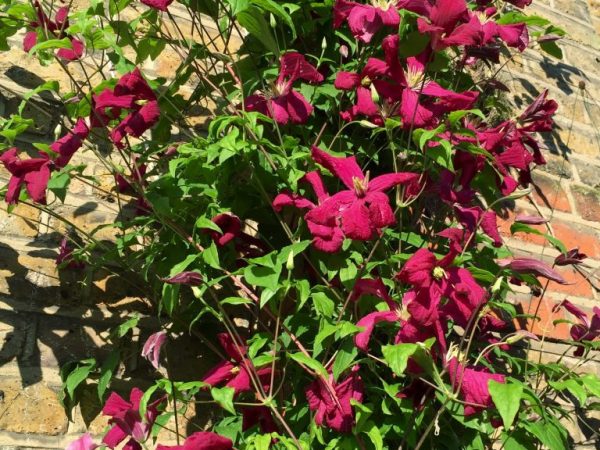
Madame julia correvon clematis photos
In regions with harsh winters, the bushes are mulched with a thick layer of sawdust, and an air-dry shelter of arches or boxes and agrotextile is installed on top.
Reproduction methods
Clematis can be propagated in the garden yourself. There are several ways:
- cuttings;
- layering;
- division of the bush.
Cuttings
Cutting is a difficult path. Green shoots in the bud stage are taken on cuttings. Pieces of stems with two nodes are soaked for a day in a rooting stimulator. Then they are planted in cups with a loose disinfected substrate.
Rooting can take several months. Only a year later, the plants can be planted in open ground.
Layers
In June, the shoots are bent into grooves with fertile soil, sprinkled with earth. The cuttings are also separated from the mother plant and planted in a permanent place after a year.
By dividing the bush
This is how adult bushes over three years old are propagated. This operation can be carried out both in the spring before bud break and in the fall. The bush is cleaned of stems, carefully dug out.With a sharp shovel or knife, it is divided into parts with several buds and a root lobe.
The slices are sprinkled with crushed charcoal. When planting, the root collar is deepened.
Diseases and pests
If not properly cared for, your clematis can get sick. The causes of diseases are often stagnant water, poor ventilation, soil acidification. Prevention consists in the device of drainage, loosening, weeding, sanitary cleaning. In spring and autumn, the base of the bush is sprayed with a solution of copper sulfate or Bordeaux liquid.
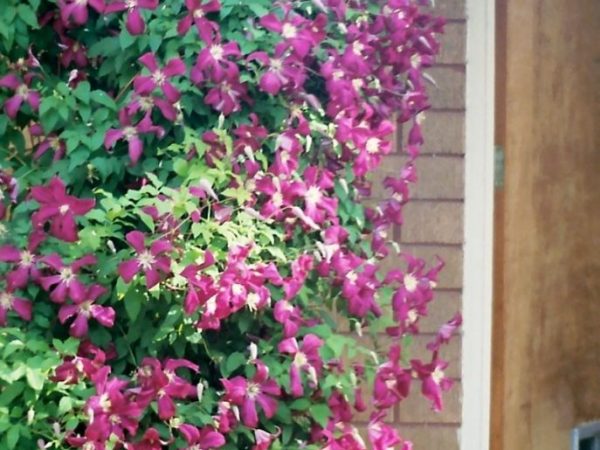
Clematis Julia Correvon Description
- Fusarium wilting. Control measures: removal of affected shoots by watering with a solution of Fundazole 1 g / l of water.
- Gray rot is manifested by brown spots with gray pubescence on the leaves. Fight - spraying with Fundazol solution.
- Powdery mildew - white bloom on the leaves. Treatment - spraying with a copper-soap emulsion (25 g of copper sulfate and 250 g of liquid soap per bucket of water) or soda ash solution (40 g per bucket of water).
Among the pests of clematis, there are aphids, spider mites. They use insecticide solutions prepared according to the instructions.
Testimonials
According to the reviews of Russian flower growers, Madame Julia Correvon's clematis are suitable for beginners. They grow quickly, are able to cover a large area with shoots. They decorate well the walls of buildings, arbors, braids arches.
Flowers are medium-sized, but graceful and are formed in large quantities. The variety blooms for a long time, from June to August.

